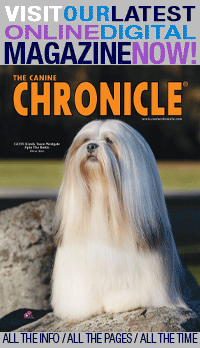On Showmanship

From The Archives 74 – May, 2010
by Dr. Gareth Morgan-Jones
On that particular day, in the not-too-distant past, there were several good quality dogs in competition but it was perfectly obvious to any knowledgeable onlooker reasonably familiar with the breed being judged that there was one exhibit which stood out, head and shoulders, so to speak, above the rest. It was clearly the best in terms of make, shape, movement and ‘type’. But yet it failed to go Winners and its breeder-owner-handler had to settle for the Reserve position. Now it so happened that the said entry was not especially well trained, had not been shown in quite a while, and failed to give appropriate ears at the right moment in time when the display of alertness and expression was presumably critical! Lo and behold, trouble. As the judge was handing out a ribbon of the purple-and-white-stripe variety he volunteered the following unsolicited remark: “I gave him plenty of opportunity”. Now evidently the person passing on the dogs was abundantly well aware of the fact that the dog getting the shaft was superior to the one being awarded the Championship points and apparently felt a need to cover himself by offering this rather smart–alecky comment (if that is the right way to describe it). To add fuel to the discomfort of the exhibitor, a friend, who had been watching the proceedings, came up and said the following: “you deserved to win but you were out-handled”. Now what do you, the reader, make of all this? Put in context of the ostensible reason for holding dogs shows, the evaluation of breeding stock, how does this sort of scenario strike you? How much emphasis should a judge place on the showmanship aspect of competition as opposed to evaluation of the respective merits of the dogs as conformational examples of their breed? Do we always have the balance right in this regard or are we in the habit of allowing one aspect, how well or otherwise a dog shows, to dominate and influence decision making?
It so happened that another judge twenty-hour hours earlier, a well-known and highly respected person of the female gender, in the same competition, was much less fastidious and more forgiving with regard to the presentation department and had awarded the more deserving exhibit, in terms of breed type and conformation virtues, Winners. So how should one view a situation where one individual had high and capricious standards, was clearly difficult to please, demanded excessive handling perfection, while another paid less attention to the superficial and concentrated more on the dogs themselves rather than on how they performed? How much room is there for the more meticulous, overly sensitive, demanding attitude when it comes to showmanship, as opposed to a largely laissez-faire, broad-minded and tolerant approach? Is a practice characterized by deliberate abstention from being unduly exacting the best way of dealing with this type scenario? You tell me! This becomes a matter of choice within a particular context and there is surely a certain responsibility attached. We come back again to the central purpose of exhibiting dogs in conformation competition. Is it about how well they show or is it about how useful they are likely to be as breeding stock going forward? Should it be a little bit of both, should it be more of one than the other. If so, which one? Interesting options!
These are, of course, philosophical questions which we all, from time to time, have to confront if we are serious about what we are trying to do when we judge. Where does the determination of structureal, movement, and ‘type’ virtues end and the showmanship dimension begin? How should one go about the business of keeping everything in proper perspective and maintaining some semblance of meaningful balance? Should how well a dog shows be merely icing on the cake or an integral and significant part of the merit equation? A couple of weekends preceding the time of writing this essay, several judges, including myself, were faced with a most interesting dilemma. An exhibit of a newly recognized Hound breed which was clearly in a league of its own among a rather mediocre entry of quite a few was so poorly trained as to make it virtually impossible to go over properly. A few others in competition that were clearly lacking in breed type showed some measure of ring preparedness. What to do? Excuse the totally untrained and somewhat unruly dog of exemplary quality and reward another of lesser merit, or give it the Breed? As could, perhaps, be reasonably expected both things happened on different, successive days. Which only goes to show how difficult it can sometimes be to make the right call. One judge (not yours truly) exercised rigor and came to the conclusion that his inability to adequately examine demanded that the dog be walked, others were more tolerant and rewarded on the basis of the positives. Who is to say which decision best met the purpose of the dog show? If the focus was kept on the potential breeding value of the respective exhibits it was an easy call. If, on the other hand, emphasis was more predominantly placed on the behavioral and showing aspects, then a differing outcome became inevitable. By the way, I’m not making any of this stuff up folks. What I’ve just described actually happened very recently!
There is no question that as the sport has evolved the desire and demand for presentation excellence has increased considerably. Professional handling has, of course, contributed greatly to raising the bar to the lofty heights now abundantly prevalent. No one can deny that this is a very good thing. But there is surely another side to the proverbial coin. Have we now reached a stage where the better presented dogs, even some of the gas-money variety, oftentimes beat out the ones of greater merit merely because of the showmanship dimension? This is obviously something to be concerned about. A judge has to be vigilant and watchful lest he or she be taken in by the ability, skill, and prowess of the handler at the expense of rationally and validly evaluating respective merits. There sometimes quite obviously exists a challenge in this regard. Some handlers can make an exhibit of average quality look good and even hide its most glaring faults and shortcomings. An exemplary dog, most will pity, when not well-handled does not always fare as well as it should. This is surely a reality which has become relatively commonplace. Is this as it should be? Perhaps not but it is not hard to figure out how this is allowed to happen. There are some habits which make possible a certain slanting and distortion of the true nature of things. Take for instance, the settled tendency to move a dog around the ring as fast as conceivably possible in an attempt to generate a certain impression. This in the hope that a judge will conclude that the dog ‘sure can move’. It can then readily become a case of aiming to create an illusion in the hope of causing a misinterpretation of actual reality. Are you following me here? We may not be quite talking about deliberately attempting that which is intellectually deceptive and misleading here but we are surely approaching that kind of area.
One of the factors which kicks in when we are considering the showmanship aspect is, of course, the subject of aesthetics, in particular the ‘what’s believed to be the most pleasing to the eye’ matter. Quite obviously there is now a collective view of how a dog should be most advantageously stacked, stretched out as far as possible to create a certain profile, a particular silhouette, however uncomfortable and unnatural this may be to the exhibit. Attempting to artificially create a certain picture, a likeness in body outline, irrespective of breed, seems now to have common currency. So also is the perceived desirability of presenting a sloping topline, withers to croup. It’s all a part of the procedure to satisfy the visual dimension, to manufacture a supposedly attractive, appealing appearance. Added to this is the tendency, referred to above, to move dogs around the ring as rapidly as possible in order to presumably generate a certain measure of excitement. So how have we gotten to this situation? Consider the following question. Have our attempts to create, in a sense, a spectator sport at the Group and Best in Show level compromised and influenced how we go about evaluating breeding stock at the Breed level? Here is another pertinent question. Why should some breeds be doing a disproportionate amount of winning in the higher categories? Is it because they are in better condition in terms of extent of development or is it because some have more inherent appeal than others in the present show ring context?
Was this something which was bound to happen, almost by default as it were, as our sport developed into what it is today, where essentially superficial excitement and spectacle have, to some extent at least, superseded and taken place of the more staid, substantive, intellectually-sophisticated reason for the dog show’s very existence? As the showmanship aspect has taken hold, the traditional way of doing things has seemingly gradually receeded. Perhaps this is a reflection of prevailing values or it may have happened merely because our activity is influenced by that which is typical of our culture at large where guiding beliefs may not always be firmly rooted. Our priorities have certainly shifted. One often wonders why, how, and when the transition occurred. It proceeded, undoubtedly, gradually. So how important, in your estimation, is this showmanship business and does it bother you that dogs which may not exactly be exemplary specimens of their breed are doing a whole lot of significant winning at all-breed events simply because they meet or exceed pizazz expectations and requirements? I can think of several which fall squarely into this category at the present time. Some dogs do, of course, transcend their shortcomings by virtue of what we might loosely call magnetic appeal. Should, however, the quality of being exciting and attractive by virtue of glamour, metabolic energy level, and vitality be an overiding factor in determining the level of a dog’s success in the show ring? Or should there be a little more depth and substance to our evaluation of a dog’s comparative merit?
ABOUT THE AUTHOR
Gareth Morgan-Jones holds a Doctor of Philosophy degree from the University of Nottingham, England, and a Doctor of Science degree from his alma mater, the University of Wales. He carries the title of Distinguished University Professor at Auburn University, where he has been a member of the faculty for thirty-seven years. He is approved by the AKC to judge Best in Show, the Hound and Toy Groups, six Sporting breeds, and Pembroke Welsh Corgis.

Short URL: https://caninechronicle.com/?p=1121











